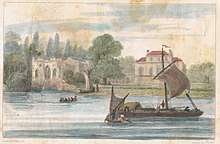Elizabeth Craven
Elizabeth, Princess Berkeley, sometimes unofficially styled Margravine of Brandenburg-Ansbach (née Lady Elizabeth Berkeley; 17 December 1750 – 13 January 1828), previously Elizabeth Craven, Baroness Craven, of Hamstead Marshall, was an author and playwright, perhaps best known for her travelogues. She was the third child of the 4th Earl of Berkeley, and was born in Mayfair in the West End of London.
Elizabeth Craven | |
|---|---|
%2C_Margravine_of_Anspach_by_Ozias_Humphry.jpg) Elizabeth, Baroness Craven, Later Margravine of Anspach, circa 1780–1783, by Ozias Humphry | |
| Born | 17 December 1750 England, UK |
| Died | 13 January 1828 (aged 77) Posilipo, Italy |
| Occupation | Writer |
| Nationality | British |
| Period | 1778–1826 |
| Subject | Travel writing, drama, memoirs |
| Spouse | Charles Alexander, Margrave of Brandenburg-Ansbach
( m. 1791; died 1806) |
| Children | 7, including William Craven, 1st Earl of Craven |
| Relatives | Augustus Berkeley, 4th Earl of Berkeley (father) Elizabeth Drax (mother) |
Works
Early in her literary career she wrote a number of light farces, pantomimes, and fables, many of which were performed in London to no great acclaim. She knew Samuel Johnson and James Boswell, and became a close friend of Horace Walpole, who published her early works which, with later efforts, include:
- The Sleep-Walker (trans. of Pont de Vile's comedy La somnambule, 1778)
- Modern Anecdotes of the Ancient Family of the Kinkvervankotsdarsprakengotchderns (satire, 1779)
- The Miniature Picture (play, 1781)
- A Journey through the Crimea to Constantinople (travel writing, 1789)
- The Georgian Princess (produced 1798; published 1799). Ed. with an introduction by John Franceschina. British Women Playwrights around 1800. 15 January 2001.
- Letters from the Right Honorable Lady Craven, to his serene highness the margrave of Anspach, during her travels through France, Germany, and Russia in 1785 and 1786 (travel writing, 1814)
- Memoirs (1826)
Very few of her musical compositions survive:
- O Mistress Mine (musical arrangement, about 1875)
- The Princess of Georgia (opera, 1799)[1]
Personal life
Her life was full of scandal: after thirteen years of marriage, seven children, and affairs reported on both sides, she and her first husband, William Craven, 6th Baron Craven, (married since 30 May 1767), parted permanently in 1780.[2] She had an affair with Charles Greville sometime in late 1783.[3] Thereafter she lived in France and travelled extensively on the Continent.
For a number of years she maintained a romantic relationship with Charles Alexander, Margrave of Brandenburg-Ansbach. During her years at the Ansbach court, Elizabeth formed an amateur theater at court, which counted the composer Maria Theresia Ahlefeldt among its members.[4] The wife of Charles Alexander since 1754, Princess Frederica Caroline of Saxe-Coburg-Saalfeld, died in Germany on 18 February 1791, and Lady Craven's husband died in Lausanne on 26 September 1791. The couple then married in Lisbon on 30 October 1791 and settled in England. While the Margravine was snubbed by ladies mindful of their reputations, as well as by her latest husband's cousin, King George III himself, and as well as by Queen Marie-Antoinette when she visited France, the couple lived a full and opulent life in Hammersmith, London, and Benham Park at Speen in Berkshire.
Nonetheless, Elizabeth was never legally entitled to share her husband's German rank and title: on 20 February 1801, she was granted the morganatic title of "Princess (Fürstin) Berkeley" by the last Holy Roman Emperor, Francis II.[5] In fact, Charles Alexander, being the last of his cadet branch of the House of Hohenzollern, and childless, had exchanged his hereditary birthright to the appanages of Ansbach and Bayreuth for an annuity of 300,000 guilders from his pater familias, King Frederick William II of Prussia, a month after his second marriage.[5] In England, however, the couple were usually known as the "Margrave and Margravine of Brandenburg-Ansbach".
After Charles Alexander's death at Benham Park in 1806, Elizabeth moved to Naples. She died at Craven Villa in Posillipo and was buried in 1828 in the English Cemetery at Naples. Her links with the Hammersmith area are commemorated in the name of two roads in the area – Margravine Gardens and Margravine Road. There is a wall monument by Roubiliac to her in St Mary's Church, Scarborough.[6]
Her children were:[7]
- William, Major-general in the Army
- Henry Augustus Berkeley (b. 1776), Major-general in the Army
- Keppel Richard (b. 1779)
- Elizabeth, married John Edward Maddocks
- Maria Margaret, married William Molyneux, 2nd Earl of Sefton
- Georgiana
- Arabella, married General the Hon. Frederick St John
Notes
- Sadie, Julie Anne; Samuel, Rhian (1994). The Norton/Grove dictionary of women composers (Digitized online by GoogleBooks). Retrieved 10 October 2010.
- Huberty, Michel; Alain Giraud; F. and B. Magdelaine (1988). L'Allemagne Dynastique Tome V Hohenzollern-Waldeck (in French). France. p. 148. ISBN 2-901138-05-5.
- Williams, Kate (2009). England’s Mistress: The Infamous Life of Emma Hamilton (Large Print ed.). BBC Audiobooks Ltd by arr. with Random House. p. 164. ISBN 9781408430781.
- "Dansk Kvindebiografisk Leksikon - Maria Theresia Ahlefeldt". kvinfo.dk. Retrieved 2014-09-21.
- Huberty, Michel; Alain Giraud; F. and B. Magdelaine (1988). L'Allemagne Dynastique Tome V Hohenzollern-Waldeck (in French). France. pp. 135, 183. ISBN 2-901138-05-5.
- Historic England. "Details from listed building database (1258195)". National Heritage List for England. Retrieved 9 September 2014.
- A Genealogical and Heraldic Dictionary of the Peerage and Baronetage of the British Empire. p. 252.
References
- Turner, Katherine. "Elizabeth, margravine of Brandenburg-Ansbach-Bayreuth (other married name Elizabeth Craven, Lady Craven) (1750–1828)". Oxford Dictionary of National Biography (online ed.). Oxford University Press. doi:10.1093/ref:odnb/576. (Subscription or UK public library membership required.)
- The Peerage.com
External links
- Elizabeth Craven at the Eighteenth-Century Poetry Archive (ECPA)
- . Dictionary of National Biography. London: Smith, Elder & Co. 1885–1900.
- Gasper, Julia. Elizabeth Craven: Writer, Feminist and European . Wilmington: Vernon Press. 2017
